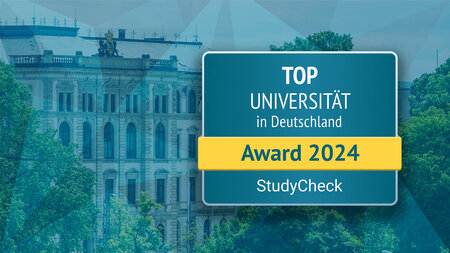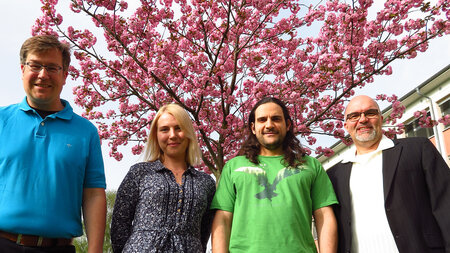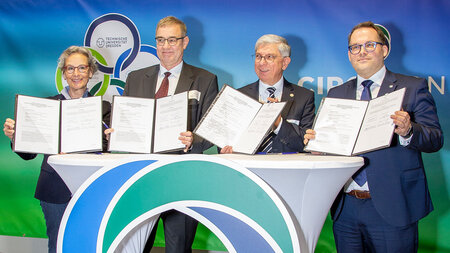Research Seminar
The seminar is intended for interested students in their Master or final stages of Bachelor studies. However, other interested listeners are cordially welcomed, too! In the seminar, either the staff of the professorship Artificial Intelligence or students will present current research topics. The presentations are normally hold in English. The precise schedule is presented in the following table.
Information for Bachelor and Master students
Seminar presentations of each major can be hold in the frame of this event. This includes mainly the "Hauptseminar" in the major Bachelor-IF/AIF and the "Forschungsseminar" in all Master majors of Informatik as well as SEKO Bachelor and Master. Attendees acquire research-oriented knowledge by themselves and present it during a talk. The candidates are expected to have sufficient background knowledge, typically acquired by a participation in the lectures Neurocomputing (formerly Machine Learning) or Neurokognition (I+II). The research topics will be typically from the fields of Artificial Intelligence, Neurocomputing, Deep Reinforcement learning, Neurokognition, Neurorobotics and intelligent agents in virtual reality. Interested students should write an Email to Prof. Hamker, the talk itself will be scheduled after an individual consultation.
Next Events
Comparison of two motor learning models of the basal ganglia and cerebellumChristoph Ruff Thu, 2. 5. 2024, 11:30, 1/368 and https://webroom.hrz.tu-chemnitz.de/gl/jul-2tw-4nz A model of motor learning, which was developed here on the professorship by Baladron et al [1] will be compared with a motor learning model from Todorov et al [2]. Both models use a model of the basal ganglia (BG) and the cerebellum (CB). The BG chooses a certain action and reaches to that location, while the CB fine-tunes the reached location to come closer to the target or adapt the movement to an altered location. Both models have a different structure and therefore function differently. During the seminar I will give a closer overlook on how these two models differ and what are advantages/disadvantages of them. The tasks with which these two models were trained differ as well. As part of my internship, I trained the model from Baladron et al [1] with the tasks of Todorov et al [2] to see which parameter values and adaptations are necessary to get a similar result and if it even is possible to train the model with these tasks. The results of this implementation will be presented as well. |
Investigation of Reward-Guided Plasticity in Recurrent Neural Networks for Working Memory TasksMax Werler Thu, 16. 5. 2024, 11:30, 1/368 and https://webroom.hrz.tu-chemnitz.de/gl/jul-2tw-4nz A variety of recent works have indicated that Perturbation Learning provides a valid approach to train the recurrent weights of an artificial recurrent neural network. In this context, Miconi (2017) demonstrated how the thereby induced deflections of the excitation of the neurons can be captured based on information that is locally available to synapses in a Hebbian manner and how these can be integrated into a reward-guided weight update rule such that it characterizes a biologically plausible training algorithm that is capable to solve cognitive tasks. However, his learning architecture suffers from a significant flaw that effectively can prohibit learning progress for some random initial conditions and disrupt a successfully converged network towards an error level like it was observed before training. In this thesis, we investigate these scenarios intending to find the underlying network properties that cause this undesired behavior. As low intrinsic activity and imbalance between excitation and inhibition were detected to strongly correlate with these phenomena, related learning rules as well as a different input weight initialization scheme have been proposed and evaluated. While our results show that we were able to enhance the speed as well as reliability of the initial network convergence greatly, the possibility for a sudden deterioration of a temporarily successful network remains existent. |
Recent Events
Valentin Forch Thu, 18. 4. 2024, 1/368 and https://webroom.hrz.tu-chemnitz.de/gl/jul-2tw-4nz In cooperation with the Research Center for Materials, Architectures and Integration of Nanomembranes (MAIN) we develop a neural network architecture that will enable the control of autonomous modular micro robots carrying CMOS chiplets. Realizing a neural network controller on this scale poses multiple challenges: the machine must run on a minimal energy budget, minimal memory footprint, and can only be build on top of a low-level instruction set. Further, these machines should in principle be able to adapt to changing environments without a complete re-training.Neuromorphic Computing as a Low Power, Minimal Footprint Solution for Dynamical System Control
To answer these challenges, we start by optimizing recurrent spiking neural networks for simple motor control benchmarks in an evolutionary framework. The networks possess a simplified integrate-and-fire neuron model and ultra low resolution synapses. We further reduce the memory footprint by optimizing only subsets of the network connectivity matrix and by controlling multiple network weights through singular bits. By controlling the neural network and resulting motor activity, we find well-performing solutions that minimize energy consumption. Lastly, we introduce a novel approach for optimizing agents through highly parallelized swarm evolution.
ANNarchy User ForumHelge Ülo Dinkelbach, Julien Vitay Thu, 11. 4. 2024, 1/368 and https://webroom.hrz.tu-chemnitz.de/gl/jul-2tw-4nz Topics will be:
|
Auswirkungen tiefer Hirnstimulation auf gewohnheitsmäßiges Lernen der BasalganglienDave Apenburg Tue, 12. 3. 2024, 367 and https://webroom.hrz.tu-chemnitz.de/gl/jul-2tw-4nz Tiefe Hirnstimulation (DBS) ist eine wirksame Behandlungsmethode, um Bewegungsstörungen bei Dystonie-Patienten zu lindern. In einer Studie von De A Marcelino et al. (2023) wurde dazu untersucht, wie Dystonie-Patienten mit ein- oder ausgeschalteter DBS-Elektrode im Globus Pallidus pars interna (GPi) der Basalganglien (BG) eine Belohnungsumkehraufgabe lösen. In dieser Arbeit wird diese Studie mit dem Basalganglienmodell von Villagrasa et al. (2018) nachgebildet. Da die Auswirkungen von DBS weitgehend unerforscht sind, wurden vier bestehende Theorien (1) Hemmung lokaler Neurone, (2) Stimulation efferenter Axone, (3) Stimulation afferenter Axone und (4) Stimulation vorbeilaufender Fasern eingebunden und untersucht. Aus einer bisherigen Studie (Baladron & Hamker, 2020) geht außerdem hervor, dass eine plastische Verbindung (Shortcut) vom Cortex zum Thalamus gewohnheitsmäßiges Lernen in den Basalganglien unterstützt. Durch einen Wechsel zwischen einem festen und einem plastischen Shortcut konnte diese Aussage validiert werden. Außerdem wurde nach dem Umkehrlernen ein Unterschied in der Anzahl gewohnter Entscheidungen zwischen den DBS-Varianten und eine höhere Anzahl gewohnter Entscheidungen mit eingeschaltetem DBS als ohne DBS festgestellt. Diese Arbeit soll somit zu einem besseren Verständnis des Einflusses von DBS auf die BG-Schaltkreise und gewohnheitsmäßigem Lernen in den Basalganglien beitragen. |
Optimierung der Neuromodellparameter eines Spiking Netzwerkes mit NeuroevolutionTom Maier Thu, 22. 2. 2024, 367 and https://webroom.hrz.tu-chemnitz.de/gl/jul-2tw-4nz In dieser Bachelorarbeit geht es um die Verbesserung der Leistung von konvertierten Spiking Neural Networks (SNNs) um deren besonderen Eigenschaften ausnutzen zu können und gleichzeitiges eine hohe Genauigkeit zu erzielen. Dafür werden bestimmte Parameter der SNNs nach der Konvertierung und Normalisierung durch die Methode von Diehl et al. aus einem Multi-Layer Perceptrons mithilfe der Covariance Matrix Adaption-Evolutionsstrategie (CMA-ES) in einem Evolutionsprozess optimiert. Der Erfolg der Evolution wurde dabei über die Genauigkeit der Klassifizierung auf dem Fashion-MNIST Datensatz gemessen, welcher auch für die Werte des Ausgangsnetzwerks und des rein konvertierten SNN verwendet wurde. Um verschiedene Effekte der Daten auf die Evolution und die Leistung des SNN zu prüfen, wurden verschiedene Konfigurationen der Größe des Datensatzes und der beinhalteten Elemente in einzelnen Durchläufen verwendet. Die Evolution der Parameter ermöglichte eine Verbesserung in den Klassifizierungen auf ein vergleichbares Niveau wie das des ursprünglichen MLP-Modells. Also erfolgte eine starke Verbesserung der Leistung gegenüber des ausschließlich konvertiert und normalisierten SNN. |
Time Series Forecasting of Cashflow Data using Deep LearningPreksha Gampa Mon, 22. 1. 2024, https://webroom.hrz.tu-chemnitz.de/gl/jul-2tw-4nz Time series forecasting is a pivotal technique in the analysis of business operations and resource availability. It is widely used across several industries to predict future events, thereby assisting in crucial and data-driven decision-making processes. At Mercedes-Benz Mobility AG, an application called `myCashflow' is used to provide the daily forecasts of cash positioning for various Mercedes-Benz entities all around the Africa and Asia Pacific (AAP) region. This application currently relies on machine learning and traditional statistical models for the analysis and forecasting of the cashflow data. These models enable the application to capture the inherent patterns present in the time series data and generate high-precision forecasts. However, with the advancement of deep learning techniques, there is a potential for enhancing the forecasting capability of the myCashflow application, thereby assisting in better decision-making. This research focuses on exploring deep learning methodologies for forecasting cashflow data while addressing the challenges of high data fluctuations, short-length time series, and potential outliers. Three advanced deep learning methodologies are explored, namely Convolutional Neural Networks (CNN), Ensemble Empirical Mode Decomposition combined with CNN (EEMD-CNN), and Transfer learning with CNN. A comprehensive evaluation and comparison of the employed deep learning methodologies with established machine learning and statistical models are undertaken to identify the most effective and efficient approach for enhancing the predictive accuracy of cashflow forecasts. |
Erklärbarkeit von Modellen maschinellen Lernens und Anwendung auf die 2. FußballbundesligaSimon Schulze Thu, 18. 1. 2024, 1/309 and https://webroom.hrz.tu-chemnitz.de/gl/jul-2tw-4nz Methoden der eXplainable Artificial Intelligence (XAI) sind unabdingbar, um komplexe und undurchsichtige Algorithmen der künstlichen Intelligenz (KI) beziehungsweise des maschinellen Lernens (ML) erklärbar und verständlich zu machen. Zudem werden KI- und ML-Algorithmen immer häufiger im Bereich der Datenanalyse im Fußball verwendet. Diese Seminararbeit untersucht den Einsatz zweier XAI-Verfahren am Beispiel der 2. Fußballbundesliga, um für den Spielausgang ausschlaggebende Statistiken zu identifizieren. Partial Dependence Plots (PDPs) und Shapley Werte sollen erläutert und auf Modellen, welche auf Datensätzen der 2.Fußballbundesliga trainiert wurden, angewandt werden. Die Vorhersagen der Modelle sollen dadurch einen höheren Grad an Erklärbarkeit und Nachvollziehbarkeit erhalten. Mit Hilfe von PDPs kann der Zusammenhang bestimmter Statistiken und des erwarteten Spielausgangs analysiert werden, während Shapley Werte einen Einblick in den individuellen Beitrag von Merkmalen zum Endergebnis ermöglichen. Die gewonnen Erkenntnisse sollen einen tieferen Einblick in die Schlüsselfaktoren, die den Ausgang einer Partie maßgeblich beeinflussen, geben. Diese Forschung trägt zur wachsenden Disziplin der XAI, unter anderem im Bereich der Datenanalyse im Fußball, bei und verdeutlich das Potential, komplexe sportliche Ereignisse systematisch zu entschlüsseln. |
Open-ended optimization of recurrent neuromorphic architecture through neuroevolutionMartina Kraußer Tue, 16. 1. 2024, 1/367 and https://webroom.hrz.tu-chemnitz.de/gl/jul-2tw-4nz While deep neural networks achieve human-level performance in some tasks, their energy consumption if implemented on von Neumann architectures is orders of magnitude above the brain. This motivates research in neuromorphic hardware which has significant less energy consumption by operating neural networks. Frenkel et al. (2018) presented ODIN neuromorphic chip, a digital spiking neuromorphic processor with minimal size and energy consumption. However, its simplified computing architecture does not allow a straight-forward application of gradient-based deep learning techniques. Neuroevolution, a subfield of AI, is employed to train neural networks through evolutionary algorithms, avoiding gradient-based modification of individual weights. This can even reach better and faster results for tasks with high uncertainty about their destination, like playing games or movement control. The Paired Open-Ended Trailblazer (POET) algorithm, introduced by Wang et al. (2019), is surpassing traditional neuroevolutionary approaches that only focus on the adaption from agents in a fixed environment by simulating dynamically changing environments over the time. POET strategically starts with simpler tasks, building skills hierarchically and expediting problem-solving abilities. POET algorithm is used to assess the learning capabilities of the ODIN neuromorphic chip in mastering the game of Pong. The objective is to explore whether the ODIN chip exhibits a general enhancement across various game parameters, contributing to a broader understanding of its adaptability and performance in its adaptability and performance in diverse pong gaming scenarios and therefore in the task of systematically controlling movements. |
Goal-directed control over action in a hierarchical model of multiple basal ganglia loopsManuel Rosenau Thu, 21. 12. 2023, 1/309 and https://webroom.hrz.tu-chemnitz.de/gl/jul-2tw-4nz In the human brain, multiple cognitive functions are related to the prefrontal cortex, the basal ganglia, the thalamus, and their organization into cortical-basal ganglia thalamic-cortical loops. While the prefrontal cortex seems to be associated with goal-directed behaviour through cognitive control mechanisms, the basal ganglia with its dopaminergic inputs and its reward prediction error is often seen as a reinforcement learning circuit, affiliated with habitual behaviour. Goal-directed behaviour is associated with planned, purposeful behaviour, connecting actions to specific outcomes, where habitual behaviour involves actions that are often repeated and rewarded in such ways that stimuli automatically trigger them. There are still uncertainties about the specific mechanisms within the cortical-basal ganglia thalamic-cortical loops that cause a particular behaviour, and whether this can be compared to model-based or model-free behaviours. Baladron and Hamker (2020) proposed a hierarchical organization of basal ganglia loops, where each loop learns using its own prediction error signal and computes an objective for the next loop. They tested their ideas with a computational model consisting of two dorsal loops. Later the model was enhanced by adding a ventral loop prior to the dorsal loops, to select a goal signal out of an existing memory. The present thesis focuses on the question, which internal structures of the cortical-basal ganglia thalamic-cortical loops could be responsible for letting the human brain establish a habit and which ones are responsible for breaking out of habit. As a result, a long indirect pathway and a shortcut between the sensory input and the thalamus in the dorsomedial loop were implemented in the three-loop model. The different approaches were then tested and compared by performing the two-stage Markov Decision task proposed by Gillan et al. (2015). |
Representational alignmentPayam Atoofi Thu, 14. 12. 2023, 1/309 and https://webroom.hrz.tu-chemnitz.de/gl/jul-2tw-4nz Any model, or system that serves as an information processing function ultimately provides a state given a stimulus, e.g., image, text, video, etc. These states can then be measured and perhaps mapped to an embedding. Assuming the output space of an information processing function (or in case of an embedding, the embedding space of the process), as its representational space, the extent of similarity or dissimilarity between representational spaces of two seemingly different systems is referred to as representational alignment. There is a plethora of studies in the fields of cognitive science, neuroscience, and machine learning, where representations of the systems are explored to show and/or impose an alignment, under the assumption that there should exist a certain degree of similarity or dissimilarity. Sucholutsky, et al. (2023) have proposed a framework that describes representational alignment in a unified and concise manner, which envelops all the previous methods from the aforementioned disciplines. Their framework helps in not only to have a better overview and understanding of the underlying principle of such approaches and their inspirations, but also to be aware of the challenges and pitfalls, e.g., where representational alignment could hinder the performance, or a representational alignment is not a valid assumption and therefore should be detected. Thus, studies in cognitive science, e.g., behavioral studies, semantic cognition, human-machine alignment, etc., or in neuroscience, e.g., brain activity functions across species or across individuals, multi-modality across brain regions, etc., or in machine learning, e.g., knowledge distillation, interpretability, semantically meaningful representation, etc., could hopefully benefit from any interdisciplinary development of representational alignment. |
Consciousness in Artificial Systems: Bridging Sensorimotor Theory and Global Workspace in In-Silico ModelsNicolas Kuske Thu, 30. 11. 2023, 1/309 and https://webroom.hrz.tu-chemnitz.de/gl/jul-2tw-4nz In the aftermath of the success of attention-based transformer networks, the debate over the potential and role of consciousness in artificial systems has intensified. Prominently, the global neuronal workspace theory emerges as a front-runner in the endeavor to model consciousness in computational terms. A recent advancement in the direction of mapping the theory onto state-of-the-art machine learning tools is the model of a global latent workspace. It introduces a central latent representation around which multiple modules are constructed. Content from any one module can be translated to any other module and back with minimal loss. In this talk we lead through a thought experiment involving a minimal setup comprising one deep sensory module and one deep motor module, which illustrates the emergence of latent sensorimotor representations in the intermediate layer connecting both modules. In the human brain, law-like changes of sensory input in relation to motor output have been proposed to constitute the neuronal correlate of phenomenal conscious experience. The underlying sensorimotor theory encompasses a rich mathematical framework. Yet, the implementation of intelligent systems based on this theory has thus far been confined to proof-of-concept and basic prototype applications. Here, the natural appearance of global latent sensorimotor representations links two major neuroscientific theories of consciousness in a powerful machine learning setup. As one of several remaining questions it may be asked, is this artificial system conscious? |
Untersuchung von Finetuning und Transfer Learning mit Transformer-Architekturen für Altersklassifizierung von TextenSebastian Neubert Mon, 20. 11. 2023, https://webroom.hrz.tu-chemnitz.de/gl/jul-2tw-4nz Die vorliegende Masterarbeit untersucht Finetuning und Transfer-Learning für die Altersklassifikation von Texten mit Hilfe von BERT-basierten Modellen. Vier zentrale Forschungsfragen werden durch verschiedene Experimente beantwortet. Zunächst wurde der Einfluss der Chunk-Größe beim Zerlegen des Datensatzes auf die Modellperformance untersucht, wobei größere Chunks eine bessere Gesamtleistung aufwiesen. Die Untersuchung von Klassifikationsschichten zeigte, dass LSTM-basierte Schichten für diesen Anwendungsfall zu besseren Resultaten führen als lineare Schichten. Das Einfrieren von BERT-Schichten während des Trainings zeigte die Bedeutung der Kapazität der Klassifikationsschicht für optimale Genauigkeiten. Schließlich ergab das Transfer-Learning mit zuvor auf verschiedenen Datensätzen trainierten Modellen keine Leistungssteigerung auf dem Audory-Datensatz, aber ein tieferes Verständnis der Vorhersagecharakteristika. Trotz einiger Einschränkungen beleuchtet diese Arbeit die Tiefe und Feinheiten der Altersklassifikation in Texten und liefert wertvolle Einblicke und Grundlagen für zukünftige Forschungen auf diesem Gebiet. |
Replication of Morris et al. 2016 and resolution proposal for prominent seemingly conflicting in vivo measurements of LIP gain-field activityNikolai Stocks Thu, 16. 11. 2023, 1/309 In 2012 Morris et al. produced a set of in vivo direct measurements of the Area LIP, VIP, and MST. When viewed at the population level, these neatly align with observed patterns of perisaccadic mislocalization, as with the broad outline of the model of perisaccadic mislocalization first developed by Ziesche and Hamker. In 2016, they then trained an intentionally simple set of integrators using linear regression on their recorded 2012 dataset, showing that their Dataset allows for the easy and accurate prediction of the future eye position up to 100ms before saccade onset, and the accurate recollection of past eye positions up to 200ms after saccade onset. Meanwhile, Xu et al. 2012 also recorded LIP activity in vivo, providing a set of measurements in contradiction with the recordings of Morris, calling into question the LIP gain-field as a viable explanation for perisaccadic visual stability. I will present one possible resolution for the apparent contradiction between the datasets of Xu et al. 2012 and Morris et al. 2012 while replicating the same kind of prediction and recollection as shown in Morris et al. 2016 using data generated by an iteration of Ziesche and Hamkers model. |
Dataset Refinement for Object Detection by leveraging the Training Dynamics of Deep Neural NetworksSujay Jadhav Mon, 30. 10. 2023, https://webroom.hrz.tu-chemnitz.de/gl/jul-2tw-4nz Object detection involves locating the instances of semantic objects in the image and classifying them correctly. The presence of incorrect class labels, incorrect bounding boxes, low resolution, unusual viewpoint, and heavy occlusion harm the detection performance. In large object detection datasets, filtering out instances with these errors is tedious and often requires manual inspection. Our goal is to identify and prune such erroneous and uninformative instances from the object detection datasets. A promising data-centric approach to diagnosing a labeled dataset at the instance level is to monitor the dynamics of the model trained on it. This thesis adopts the dataset maps (Swayamdipta et al., 2020) from text-classification tasks to object detection tasks. By diagnosing the dataset maps for the object detection dataset, this thesis provides a proof-of-concept for object-level pruning of large detection datasets. The position of the objects on the dataset map indicates its difficulty for the model in three categories - easy, ambiguous, or hard to learn. To further filter out the object instances that do not contribute to learning, other training dynamics such as correctness - how often the object is correctly classified, and forgetfulness - how often the model misclassifies the object after correctly classifying it, are explored to find out their potential for object pruning. The thesis shows that collectively pruning some easy and most of the hard-to-learn objects can improve the detection performance of the model, with less data. |





